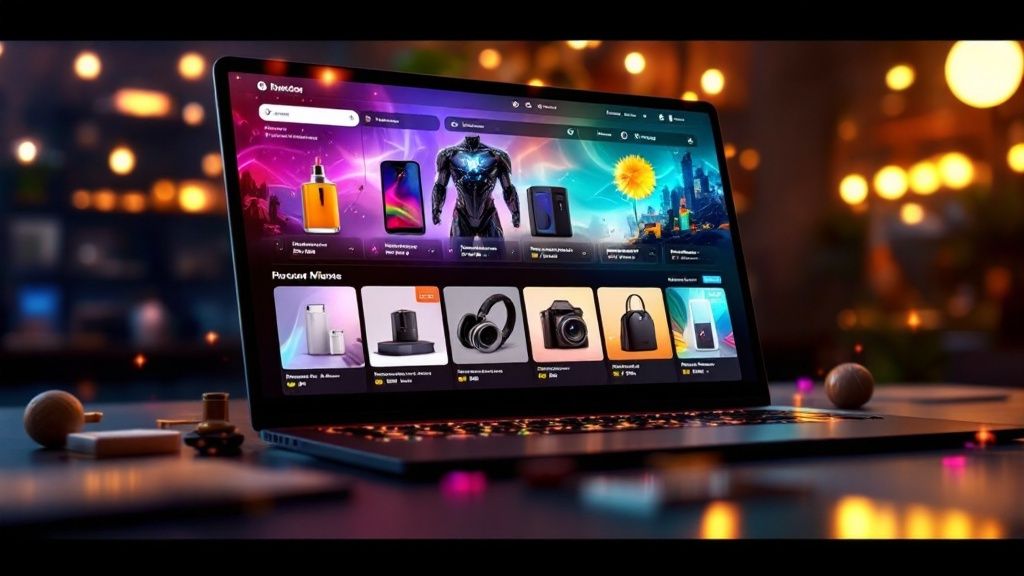How to Improve Ecommerce Sales: 10 Strategies That Actually Work
December 23, 2024

Creating Personalized Shopping Experiences That Convert

The data speaks clearly – personalization directly impacts sales success. Research shows that customized content can boost revenue by over 25%, and shoppers are 40% more likely to spend beyond their initial budget when presented with personalized experiences. Creating individual experiences that make customers feel understood isn't just good service – it's essential for improving conversion rates and growing sales.
Understanding Your Audience For Effective Segmentation
The foundation of effective personalization lies in truly knowing your customers. This means going beyond basic demographics to understand purchase patterns, browsing behaviors, and expressed preferences. For example, you might group customers into segments like first-time buyers, repeat purchasers, and high-value clients. Each segment has distinct needs and motivations. When a returning customer sees product suggestions based on their past purchases, it creates a natural, relevant experience that encourages them to engage further with your brand.
Implementing Personalized Recommendations That Work
After segmenting your audience, you can create targeted recommendations using customer data insights. This could mean suggesting complementary items for products in their cart, showing items similar to past purchases, or highlighting popular items in their preferred categories. Think of it as having a knowledgeable sales associate who remembers a customer's preferences and can make thoughtful suggestions – just scaled for online shopping. For more insights, check out this guide on How to master ecommerce personalization.
Choosing The Right Personalization Tools
Success depends heavily on selecting tools that match your specific needs. Some platforms excel at email personalization, while others focus on product recommendations or website customization. Key factors to evaluate include: how easily the tool integrates with your current systems, ability to scale as you grow, and level of customization offered. Some solutions provide AI-powered automation, while others need more hands-on configuration. Take time to assess which features matter most for your business goals and budget.
Measuring The ROI of Personalization
To optimize your personalization strategy, track key metrics beyond basic conversion rates. Monitor customer lifetime value, average order size, and retention rates to understand the long-term impact. This data helps you refine your approach and ensure personalization efforts deliver real business results. Regular analysis lets you identify what works best for your specific customers and adjust accordingly. Focus on metrics that show sustained growth rather than short-term gains.
Mastering Mobile Commerce for Modern Shoppers

Mobile devices have become the primary way people shop online, making mobile commerce essential for business growth. Recent data shows mobile commerce sales will reach $2.52 trillion in 2024 – a 16.6% increase from last year. This rapid shift means businesses must adapt their strategies to serve customers who primarily browse and buy on their phones.
Optimizing For Speed and Simplicity
When shopping on mobile devices, users have little patience for slow-loading pages or complex navigation. Research confirms that even one second of delay can significantly reduce conversions. To improve sales, focus first on maximizing your mobile site's loading speed.
Keep your mobile interface clean and uncluttered. Present product information clearly with large, high-quality images that work well on small screens. Use concise descriptions that highlight key features and benefits. By removing unnecessary elements and emphasizing what matters most to shoppers, you make it easier for them to find and purchase what they want.
Designing Thumb-Friendly Interfaces
Simply shrinking a desktop site isn't enough – mobile design requires understanding how people actually use their phones. Most users browse one-handed, using their thumb to tap and scroll. Place important buttons and menus within easy thumb reach. For example, position the "Add to Cart" button where users can tap it naturally while holding their phone. This attention to ergonomics makes shopping more comfortable and increases the likelihood of completed purchases.
Streamlining The Mobile Checkout Process
The checkout experience often determines whether a shopper completes their purchase or abandons their cart. Mobile users expect a quick, smooth path to purchase with minimal typing required. Include features like one-click checkout, guest checkout options, and address auto-fill to reduce friction. Offer popular mobile payment methods like Apple Pay and Google Pay. Small improvements to checkout flow can dramatically boost your conversion rates. Review your checkout analytics regularly to identify and fix any points where customers drop off. Building an efficient, user-friendly mobile shopping experience pays off in higher sales and satisfied customers.
Building Email Marketing Campaigns That Drive Sales
Email marketing remains one of the most effective ways to boost online sales when done thoughtfully. Rather than sending generic promotional blasts, successful email campaigns focus on building relationships with customers and guiding them naturally through their buying journey. Email gives you a direct channel to connect with customers, share valuable information, and encourage purchases at the right moments.
Segmenting Your Audience for Targeted Messaging
The foundation of effective email marketing is understanding your audience segments. By dividing your email list based on customer behaviors, purchase patterns, and interests, you can create messages that resonate with each group. A first-time customer might receive a welcome series with an introductory discount, while your VIP customers get early access to new products and exclusive offers. This personalized approach makes your emails more relevant and engaging, leading to stronger customer relationships and increased sales over time.
Automating Email Workflows for Maximum Impact
Think of email automation as having a dedicated sales team working around the clock to nurture leads and support customers. By setting up targeted workflows, your emails can automatically respond to specific customer actions. For example, when someone abandons their cart, a gentle reminder email with a small incentive can bring them back to complete their purchase. After a successful order, follow-up emails can suggest complementary products and encourage the next purchase. You might be interested in: How to master ecommerce and improve sales. This systematic approach keeps your brand present in customers' minds while encouraging repeat business.
Crafting Compelling Email Content That Converts
The content within your emails needs to capture attention and drive action. Your subject lines should stand out in busy inboxes, while the email body must deliver clear value – whether that's highlighting new products, sharing useful tips, or offering special deals. Rather than just announcing a sale, tell the story behind your products and explain how they solve customer problems. Include high-quality product images and videos to showcase items effectively. This content-first approach helps your emails feel more like valuable communication rather than pure promotion.
Measuring and Optimizing Email Campaign Performance
Success in email marketing requires constant monitoring and improvement. Track essential metrics like open rates, click rates, and conversions to understand what resonates with different customer segments. Test various subject lines, content approaches, and calls-to-action to find what works best. For instance, if open rates are low, try new subject line formats. If click rates need improvement, adjust your call-to-action placement and messaging. Regular analysis lets you refine your approach over time and maximize the impact of email on your overall sales. The key is viewing optimization as an ongoing process – small improvements add up to significant results for your bottom line.
Using AR Technology to Elevate Shopping Experiences
Beyond email marketing and mobile optimization, augmented reality (AR) is emerging as a powerful tool for improving online sales. What was once seen as futuristic technology has become an essential shopping feature. AR creates an interactive bridge between digital and physical shopping, giving customers the ability to virtually try products before buying. This capability builds buyer confidence and helps drive more sales.
Which Product Categories Benefit Most From AR?
Products that need visualization and interaction see the greatest impact from AR technology. For instance, furniture retailers use AR to help shoppers place virtual furniture pieces in their actual rooms. This simple but effective solution removes a major obstacle – uncertainty about whether items will fit or match existing decor. Fashion brands have adopted virtual try-on features that show how clothes look on customers without physical fitting rooms. Beauty companies also use AR effectively, letting shoppers experiment with makeup shades digitally. As a result, customers make more confident purchases and return items less frequently.
Implementing AR Features on a Budget
Adding AR to your store doesn't require a massive investment. While custom AR development can be expensive, many affordable options exist for businesses of any size. For example, Shopify provides AR app integrations that are simple to set up without technical expertise. Many platforms offer ready-made AR models for common products, making implementation faster and more cost-effective. With tiered pricing available, small businesses can start basic and expand AR features as needed to test the impact on sales.
Measuring the Impact of AR on Your Bottom Line
To understand how AR affects your sales, focus on specific metrics beyond basic conversion rates. Compare the average order value between customers who use AR and those who don't to see if AR encourages larger purchases. Monitor how long shoppers engage with AR features to assess interest and identify ways to improve the experience. Pay attention to return rates for AR-viewed products – lower returns indicate that AR helps customers make better purchase decisions, saving costs while improving satisfaction. For additional ways to boost your Shopify sales, explore how Checkout Links can simplify purchasing through shoppable product links.
Crafting Content and Influencer Strategies That Sell

When content marketing joins forces with influencer partnerships, it creates a potent combination for driving online sales. Studies show this strategy works – 61% of US online shoppers have purchased items based on blog recommendations. By creating targeted content that speaks to your audience's needs, you can guide their buying decisions and boost your bottom line.
Creating Content That Converts
Effective content does more than fill space on your website – it helps solve real customer problems. Start by deeply understanding your target audience's challenges and desires. Instead of simply listing product features, create blog posts, videos, and infographics that demonstrate practical solutions. Share educational content that positions your brand as a trusted resource. When you consistently deliver value, you build long-term relationships that lead to repeat purchases.
Identifying and Partnering With the Right Influencers
Finding the perfect influencer match requires looking beyond follower counts. The key is partnering with creators whose audience overlaps with your target customers. For example, a beauty brand might collaborate with a makeup artist who shares their commitment to cruelty-free products. These authentic partnerships build trust because the influencer genuinely believes in your brand. Focus on finding partners who can naturally weave your products into their content rather than forcing promotional messages.
Choosing High-ROI Content Formats
Different types of content resonate with different audiences. Test various formats like blog posts, videos, social posts and interactive content to see what drives the best results. Video content excels at demonstrating products in action, while detailed blog posts help with SEO. User-generated content provides social proof that builds trust. Track which formats deliver the strongest ROI and double down on what works for your brand.
Measuring the Impact on Sales Performance
Data helps you optimize your content and influencer strategies over time. Monitor key metrics like website traffic, engagement, conversions and revenue from specific campaigns. If an influencer partnership drives lots of visitors but few sales, analyze the content and targeting to identify improvements. Let the numbers guide your decisions so you can refine your approach and generate sustainable growth. Regular measurement ensures your marketing efforts align with your sales goals.
Optimizing Your Sales Funnel Through Smart Testing

Getting visitors to your store is only half the battle – converting them into customers requires a well-optimized sales funnel. By carefully analyzing data and testing different approaches, you can identify and fix the issues that prevent shoppers from completing their purchases. This systematic process helps you make informed improvements rather than relying on hunches.
Identifying and Eliminating Conversion Barriers
Think of your sales funnel as a pipeline where potential customers can leak out at various points. Common issues include confusing checkout flows, slow page loads, and unclear product information. For instance, if many shoppers abandon their carts during payment, you likely need to review your payment options or add more security badges. Similarly, high bounce rates on product pages often point to inadequate product descriptions or low-quality images that fail to give shoppers the details they need.
Implementing Effective Testing Strategies
After spotting potential issues, targeted testing helps confirm the best solutions. While A/B testing different elements is common, effective testing goes deeper than surface-level changes. You might test different product page layouts, adjust how key information is presented, or try new checkout flows. Focus your testing efforts on the areas that will have the biggest impact on sales – like addressing major drop-off points or finding ways to increase average order values.
Making Data-Driven Decisions
Good testing relies on tracking the right metrics and analyzing them properly. Beyond basic conversion rates, examine metrics like average order value and customer lifetime value. Break down the data by customer segments to uncover specific improvement areas. For example, you may find that new customers struggle with account creation while returning customers need a faster checkout process. This detailed analysis helps you make targeted improvements for different customer groups, similar to a detective following clues to solve a case.
Practical Examples of Successful Optimization Experiments
Real-world examples show how small changes can drive big results. One retailer boosted sales by simplifying their checkout form and adding a guest checkout option. Another company reduced cart abandonment by sending personalized follow-up emails with product recommendations and modest discounts. These cases demonstrate how methodical testing and optimization can steadily improve your store's performance and bottom line.
Want to streamline your checkout process and boost your Shopify sales? Checkout Links helps simplify purchasing with customizable shoppable links. Learn more about Checkout Links and how it can help you improve your ecommerce sales today.
 Checkout Links
Checkout Links



